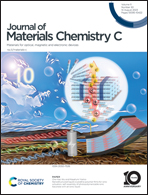Developing single silane-derived delayed fluorescent carbon dots as donors for energy transfer-based aqueous-phase multicolor afterglow application†
Abstract
Developing aqueous-phase and metal-free room temperature (RT) long-afterglow materials should be of great significance for printable anti-counterfeiting encryption, LEDs and autofluorescence-free biosensing and bioimaging. However, the utility and reliability are greatly limited by the unstable structure of organic phosphors and thermally and moisture-induced emission quenching. Herein, silane-derived aqueous-phase delayed fluorescence (DF) carbon dots (CDs) were prepared using a hydrothermal route with 1,3-bis (3-aminopropyl)-1, 1,3,3-tetramethyldisiloxane as a single carbon precursor. The formed Si, N self-doped CDs subsequently embedded in a silica matrix (denoted as DF-CDs@SiO2) display bright blue RT-DF with a fluorescence quantum yield (QY) of 35.11% and an afterglow lifetime of about 434 ms, which can be observed with the naked eye for 10 s. The silica network formed by the hydrolysis of the silica–oxygen bonds in the silane can effectively limit the vibrations of the underlying chromophore of the CDs and achieve efficient DF emission. In particular, DF-CDs@SiO2 can be used as an efficient donor for multicolor afterglow via Förster resonance energy transfer, which has strong potential for applications in advanced information encryption, LEDs, hydrogel-based biosensing, and autofluorescence-free bioimaging.



 Please wait while we load your content...
Please wait while we load your content...